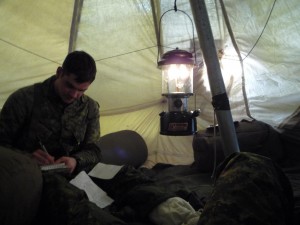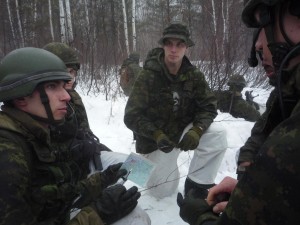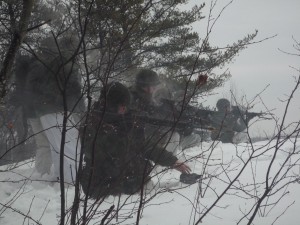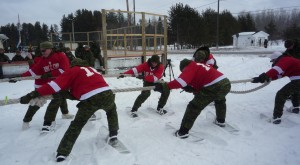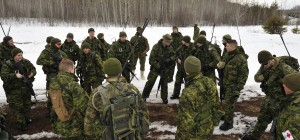
RMC (7) Platoon – Ex WOLF PACK ENDEAVOUR
24928 OCdt (IV) Quenton Baldock
On the evening of Tuesday, 15 March, 2011, twenty-seven officer cadets of the Royal Military College of Canada departed from the parade square on a charter bus bound for the northern community and vast surrounding wilderness of Gogama, Ontario. The RMC platoon had spent several weeks prior to this day honing their skills and equipment in preparation for 33 Canadian Brigade Group’s annual winter warfare exercise, designated WOLF PACK ENDEAVOUR (a reference to the iconic howling wolf that appears on the brigade’s shoulder emblem). Acting as platoon commander, OCdt (IV) Harold King, 25124, and aided by his platoon 2IC, OCdt (III) Mark Moffat, 25152, both recent graduates of the highly arduous Dismounted Infantry Platoon Commander course (colloquially known as Phase III Infantry) the two administer and lead the fresh, eager bunch as they step off. Many of the young men, and woman, OCdt (I) Vanessa Banks, 26193, had never experienced first-hand the concept of winter training and leapt at the chance to do so; this exercise was by no means obligatory to them. Accompanying them for support and mentorship are OCdt J Wotherspoon, M0985, from Otter Squadron and Captain KJ Schamuhn, 22094, 12 Squadron Commander, whose time and efforts were focused on nothing less than ensuring total mission success for the RMC platoon.
After completing the 833 kilometre drive north to Gogama, the RMC platoon disembarked heavy laden with vests, weapons, rucksacks, radios and toboggans, and marched out to the nearby Gogama airfield. Situated along this long, frozen stretch of open road was the 33 Brigade contingent, numbering several hundred strong (including soldiers on exchange from the United States Army National Guard) living in a network of arctic and modular tents. In addition to were a group of Canadian Rangers whom as part of winter warfare training were instructing the soldiers in constructing improvised shelters, trapping and snaring, forestry, and perhaps most important of all, baking bannock. Designated as 7 Platoon, the RMC cadets were tasked in a light infantry role on a company sized operation to conduct a raid on an enemy encampment working hand in hand with officers and non-commissioned members of several Primary Reserve units in Ontario. After having ample time to rehearse, rest, eat and hydrate, the platoon marched north through the snow and rain and after conducting their thorough reconnaissance, waited for H-hour to come.
When the first shots rang out in contact with the enemy 7 Platoon pushed forward with explosive precision and fury. Smoke and flashes permeated the air and the scent of burning cordite wrestles the nostrils while voices cry out various battle drill instructions. With myself acting as platoon signaller, the exchange of information through my headset crackling in my ear was a constant reminder that amidst the chaos there still exists a plan to all this. In between breaths, bounds and firing my weapon I relayed our contact and situation reports back to the company command post, where the need for hard information is constantly present. After sweeping through the objective, 7 platoon conducted a fighting withdrawal into an established friendly position, where our sister platoon was waiting to conduct their own ambush of the enemy’s impending counterattack as our retreat would draw them out and funnel them into our gunsights.
Once the action had finally ceased the platoon trudged its way, cold, tired and sweat-ridden, back through the wilderness to the airfield. Awaiting us upon arrival in the dark of night was hot soup and bread while the command elements conducted their respective after action review. During the night the temperature dropped considerably and the need to keep both one’s person and their kit warm and dry becomes paramount.
The final two days of the exercise was characterized by a sport and military skills contest between all the units present. Dividing its members up into two separate competing teams, the RMC platoon performed exceptionally in each event with the final scoreboard listing them in first and third place respectively. On the members own time, independent from the rest of the brigade, the RMC platoon received additional training from Captain Schamuhn on the conduct of a platoon hasty attack. Speaking as a candidate awaiting Phase III Infantry training this summer, I found this additional time spent (free of formal assessment with no directing staff breathing down one’s neck) was invaluable and gave me an excellent perspective in which to frame subsequent training.
For our final night in the field, several members of 7 platoon opted to sleep separate from the platoon bivouac in improvised shelters made of nothing more than logs, branches and packed snow. With temperatures reaching as low as -25 degrees, we nevertheless stayed warm and dry next to our burning fires. During the final awards presentation, 33 Brigade Commanding Officer, Colonel Waite, personally thanked the platoon for our presence there and presented us with a commemorative plaque (which is to be mounted and proudly displayed in Bill & Alfie’s, the cadet drinking mess). With Ex WOLF PACK ENDEAVOUR 2011 over, the members of 7 platoon proceeded to tear down and pack up all the while weary but jubilant over the results of a time well spent. With chapped lips, red skin and an overall dishevelled appearance, the officer cadets stepped off the bus back onto the parade square shortly after midnight on Sunday, 20 March. After much needed showers and a few hours rest the platoon promptly cleaned and returned their weapons and kit in between exchanging smiles, laughter and stories; morale couldn’t have been higher.
In one man’s opinion I would say that this opportunity was the best training experience I have had the fortune to receive since being at the military college. Secondary to the spit and polish nature of parades and inspection, the true measure of military training is in the hard time spent soldiering. It is a test of one’s body; of what your physical limitations may be (and how to overcome them). Simultaneously it is a test of one’s mind; of the necessary cognisance to not only effectively lead, but at times to effectively follow.
As Captain Schamuhn often reminded us, any fool can be uncomfortable in the field. Distinguishable from this is the professional and well-trained nature of Canadian Forces members who are prepared and able to work comfortably in any and all conditions and still achieve mission success. As future leaders in said organisation it is absolutely necessary that officer cadets get opportunities like those of WOLF PACK ENDEAVOUR to punctuate their studies and time on the parade square in order to frame the theoretical with the practical. I for one strongly urge the cadet wing leadership of subsequent years to push for and maintain the positive working relationship with 33 Brigade Group to have this excellent opportunity repeated.
On a side note to the class of 2011: 54 days to graduation!
L’exercise Wolfpack Endeavour
24752 Elof (IV) Marc-André Lussier
Le CMRC à déployé la semaine dernière un peloton à Gogama, On dans le cadre de l’exercise Wolfpack Endeavour du 33e GBC. Le premier défi de l’exercise consitait au long et pénible trajet d’autobus (je vous mets au défi d’aller sur Google Map et de voir le trajet). Avec quelque pause obligatoire dans les Tim Hortons, nous sommes arrivés au Centre communautaire de Gogama vers 0430h. Après un dernier ajustement à notre équipement et un déjeuner santé….on est monté vers l’aéodrome qui servait de site de bivouac à la Brigade.
Notre première journée à Gogama consistait à une journée d’instruction dirigée par les Rangers canadiens. Bien qu’ils n’enseignent pas de manière militaire, efficace et uniforme, ils ont un savoir énorme et n’héssitent pas à partager leur connaissance. Ils nous ont dabord montré comment allumer un feu avec un simple couteau et un bloc de magnésium, comment installer des collets et comment construire différents types d’abris de fortune. En après-midi, le peleton a construit un abri sous la supervision des Rangers et ces derniers étaient très impressionner par le travail des Élofs. Alors que certains s’affairaient à trouver des branches de sapin pour faire les murs, d’autres recherchaient des arbres ou des branches assez long qui serviraient pour la fondation. Une fois l’abri terminé, les Rangers nous ont expliqué comment prendre soins des outils et comment les aiguiser. Afin de conclure l’entraînement avec les Rangers, ces derniers nous ont aidé à faire de la banique. Dessert de première qualité qui mériterait sa place à la salle à manger des Élofs selon plusieurs.
En fin de journée, le commandant de peleton, 25124 Élof Harold King, recevait ses ordres. Après une coordination avec le peleton 2 constitué provenant d’une des unités du 33e GBC, nous nous sommes vites dirigé vers nos tentes afin de réchauffer et discuter au niveau de section de ce qui nous attenderait le lendemain.
Le jeudi matin, l’Élof King donnait les ordres au peleton 7 de la compagnie A. Le peleton 7 devait effectuer un raid sur une position ennemie en début de soirée. Après d’autre préparatif, c’est sous la pluie que les Élofs du CMRC se sont mient en marche dans quelques pieds de neige, au travers d’une forêt dense en direction de la position qui devait déjà être occupée et préparée par le peloton 2. Après plusieurs ambûches, nous avons finalement réussi à parvenir à établir une position précaire mais néanmoins dominante sur l’ennemie. Pour un peloton qui effectuait un premier raid, il a été remarqué que le CMRC s’en est train bien tiré….probablement mieux que la majorité des unités de réserve présente. Faut dire que tous les membres du peloton 7 était au minimum qualifié BMOC-L, anciennement PCAT (CAP). Le travail des commandants de section était donc plus facile puisque tout le monde comprenait la situation tactique et était capable de réagir de leur propre initiative. Le niveau de cohésion était digne d’un vrai peloton opérationel selon certain. Faut dire qu’après tout, le CMRC est une unité comme toutes les autres.
Le lendemain, il y avait une journée sportive entre les différentes unités de la 33e Brigade. Alors que chaque unité avait une équipe en lice, la petite délégation du Collège était représentée par deux équipes. Tout le monde voulait battre le Collège. Même lorsque nous affrontions l’équipe américaine, l’ensemble des réservistes encourageait l’équipe adverse. Le Collège a fait fier allure en remportant en autre le tournoi de soccer dans la neige en plus de quelques autres épreuves. La deuxième équipe du Collège à fini en première position alors que CMRC-1 a fini en troisième position. Le Collège, n’étant pas membre du 33E GBC n’était pas éligible à la coupe, le trophé est donc allé aux Cameron d’Ottawa en récompense de leur deuxième place. Qui sait, si le Collège est de retour l’an prochain aux cotés de ses confrères de la 33e, peut être qu’une nouvelle rivalité vient de naître.



